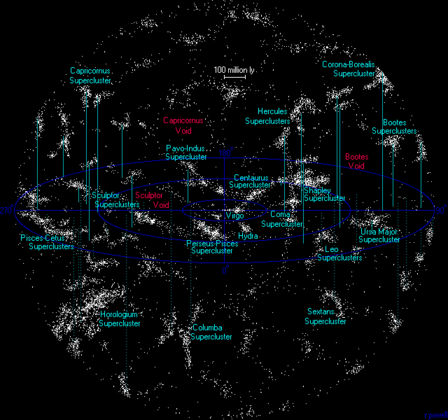[/caption]
It’s time to expand your mind and consider the largest structures in the Universe: vast collections of galaxies known as superclusters. There’s really nothing bigger in the Universe. The supercluster we live in is known as the Virgo Supercluster. It’s an enormous collection of more than a million galaxies, stretching across a region of space 110 million light-years across.
Our Sun is just one member of the Milky Way, and the Milky Way is part of a collection of galaxies known as the Local Group. This contains three large spiral galaxies: the Milky Way, Andromeda, and the Triangulum Galaxy, as well as a few dozen dwarf galaxies. The Local Group is just one member of the Virgo Cluster. This is a collection of 1200-2000 galaxies that stretch across 15 million light-years of space. And then, the Virgo Cluster is just one cluster in the Virgo Supercluster.
Although astronomers recognized that we were in a supercluster of galaxies in the 1950s, it wasn’t until the 1970s that astronomers actually mapped out the Virgo Supercluster’s shape; it has a flattened disk, somewhat like our galaxy itself. Our Virgo Cluster is actually an outlying group of the Virgo Supercluster.
The Virgo Supercluster is just one of millions of superclusters across the Universe. From the largest scales, they’re arranged in long filaments and walls surrounding even large voids of space where there are almost no galaxies at all.
We have written many articles about galaxies for Universe Today. Here’s an article about how the Universe isn’t expanding uniformly.
If you’d like more info on galaxies, check out Hubblesite’s News Releases on Galaxies, and here’s NASA’s Science Page on Galaxies.
We have also recorded an episode of Astronomy Cast about galaxies – Episode 97: Galaxies.

